 Before sunrise of the second day of the ceremony, the diiyin and both camps are busy preparing for the l-o-n-g
day and night they face, because all must be ready when the girl begins dancing at sunrise.
Before sunrise of the second day of the ceremony, the diiyin and both camps are busy preparing for the l-o-n-g
day and night they face, because all must be ready when the girl begins dancing at sunrise.
This part of the ceremony is called bildeenilk�� translated as "All alone she dances". In fact, she invariably begins dancing with an experienced friend, i.e., one who has already experienced her own
NA-IH-ES. It is not unusual to find the girl dancing by herself on the third morning of the ceremony simply because everyone else ran out of steam during the previous day - or night!
The diiyiin usually stands behind the girls, leading the singers in gohzhoosih ("Songs of harmony" i.e., beauty, goodness, etc.), groups of 4 songs (chants) which Apaches believe were originally sung by Is dz�n naadleeshe'.
No one seems the least concerned that songs composed and sung by "Changing Woman" are now sung by men (I have never seen a woman singing with the singers. Apache men tell me that is because Apache women can't sing; Apache women say it is because men do the singing).
Opthamologists would cringe at the mere thought of a girl, head held high, eyes fixed on the rising sun, dancing hour after hour after hour staring into the sun, but she has no respite! What is certain, is the girl must dance to each of the songs, and must dance to the complete satisfaction of all who attend the ceremony.
What is certain, is the girl must dance to each of the songs, and must dance to the complete satisfaction of all who attend the ceremony.
She can't run off to the toilet when her bladder wants to go. She can't sit down where she is, never mind sitting under the shade of a tree! She can't squat to give her legs a rest; she must stand straight and tall, dance correctly to every beat, ensuring her cone bells jangle with the required vigor, knowing critical eyes are watching every move she makes, looking for any hint of an expression which
Sometimes her friend will use a beautiful handkerchief to wipe the salty sweat dripping into her eyes. Invariably the eyes of that friend will register that concern, the compassion, and empathy for the girl's personal struggle to continue dancing with honour.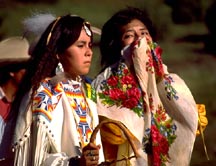 The more she dances, the higher the sun rises, and the hotter she gets under her heavy buckskin and campdress.
The more she dances, the higher the sun rises, and the hotter she gets under her heavy buckskin and campdress.
After a few hours of watching the girl dance under the hot sun (or pouring rain) non-Apaches usually comment, "Even if I was born an Apache, you would never get me to do that!" - especially after the friend is relieved from "duty" by the Sponsor, and the Sponsor doesn't offer empathy, but demands renewed performance to the required standard!
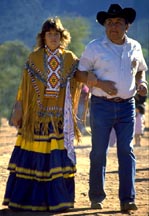
The girl is likely to be frequently corrected by the Diiyin, her sponsor, or any number of women during this stage of the ceremony. You won't find this movement in any exercise routine because it is very physically challenging, especially after a few repetitions! After the requisite songs have been sung, the girl gets to "sit". Some girls sit crosslegged, but most girls will kneel (which makes it more challenging to be penetrated by a shooting red sunbeam, but satisfies modern morality). Either way is most uncomfortable because niztah ("sitting") recreates that moment in time when Is dz�n naadleeshe' was penetrated by a sunbeam.
During the requisite groups of four songs (chants), the girl must hold her hands in an acceptable way at an acceptable height swaying from North to South in an acceptable manner.
After the requisite songs have been sung, the girl gets to "sit". Some girls sit crosslegged, but most girls will kneel (which makes it more challenging to be penetrated by a shooting red sunbeam, but satisfies modern morality). Either way is most uncomfortable because niztah ("sitting") recreates that moment in time when Is dz�n naadleeshe' was penetrated by a sunbeam.
During the requisite groups of four songs (chants), the girl must hold her hands in an acceptable way at an acceptable height swaying from North to South in an acceptable manner.
All eyes are riveted on the girl as she sways back and forth, but the most interesting eyes are those of pre-pubescent girls questioning their own ability to do Niztah! Niztah is the most photographed part of this ceremony, possibly due to the variety of expressions which flit across the girl's face, often ranging from agony to ecstasy.
Niztah is the most photographed part of this ceremony, possibly due to the variety of expressions which flit across the girl's face, often ranging from agony to ecstasy.
It is difficult for me to chose the "best" niztah photograph. The University of Arizona Press chose this one for the cover of "ARIZONA: The Land and The People" because they liked the expression on Jerilyn Gloshay's face; I like it because if ever there was to be a photograph of holy hands, Jerilyn's beautiful hands - open to the light of heaven - would be my choice. Clearly the hands of an healer, not an handmaiden!
I took many photographs of Tonita Hill, who must be the only girl in Apache history who could consistently sway from touching Mother Earth on the North to touching Mother Earth on the South; it doesn't seem humanly possible to bend so low, song after song.
I have one photo of Tammy Thomas the tabloids would probably pay a pretty penny for because in that photo, Tammy looks exactly like Sophia Loren instead of a young Apache girl.
But no matter how wonderful their performance, how magnificent their dress, nor how inspirational the moment may be, the memory which endures is the look in their eyes, that honest expression of a glorious world we all believe must exist.
After hours of strenuous movement, niztah ends, and the girl can look forward to a massage.
People usually think the girl must be grateful for an opportunity to lay down, but if you look closely at this photo, you will see Gail Case is straining to keep her head up high in the required position. Try that for a minute or two, then imagine yourself doing it through the required groups of 4 songs/chants with someone stomping all over your body!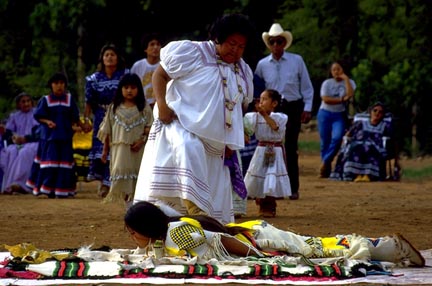 That sounds great, but niztii ("lying") isn't some grand adventure in lomilomi land! As can be seen in this photo, the massage is placing a moccasined foot where it can do some good, i.e.stepping on strained/sore muscles to make the girl fit for her next physical challenge.
That sounds great, but niztii ("lying") isn't some grand adventure in lomilomi land! As can be seen in this photo, the massage is placing a moccasined foot where it can do some good, i.e.stepping on strained/sore muscles to make the girl fit for her next physical challenge.
After her "refreshing" massage, the girl gets
to race against time.
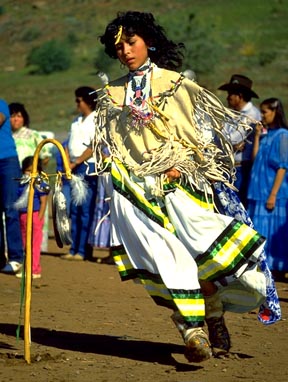 requires the girl to dance, then run around a cane and back to her position so fast no one can catch her.
requires the girl to dance, then run around a cane and back to her position so fast no one can catch her.
Each time she succeeds, the diiyin doesn't reward her by moving the cane closer and making it easier for the fatigued girl; the diiyin - oviously using inspiration as a guide - moves the cane further and further East, so she can run further and faster!
After four times of running around the cane to the East,
she gets to run around the cane to the South, West, and North.
Those who grow weary of chasing her may stop to rest, but the girl must continue to outrun their replacements! I well remember the Apache runner, Heidi Quesada's NA-IH ES because Heidi ran around the cane so fast she was back in position before the dust hit the ground!
When Heidi ran to the West, she was back in postion before anyone else reached the cane!
After outrunning everyone and continuing to dance under the hot, desert sun, the girl faces what many girls describe as the most frightening part of the ceremony:
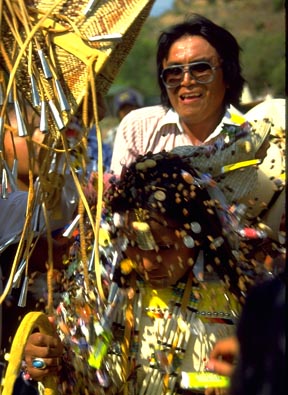
The instant the diiyin turns over the burden basket, hands appear from every conceivable direction to snatch the blessings (usually in the form of coins, candy, gum, etc.).
Some girls are clearly terrified by the sudden sea of hands thrust in their direction! Not surprisingly, Apaches are not accustomed to being mobbed! - or being among so many outstretched hands in such a small area!
And, as if she wasn't hot enough, being completely enveloped by hot, sweaty bodies usually leaves the girl gasping for fresh air. But that air will be filled with dust caused by people rushing to grab every bit of food from the long line of blessings which once stretched East to her cane. But, as every Apache knows, time continues to pass and her circumstance will change. So in no time at all, she is back in position, dancing, whilst cigarettes and pollen are distributed for the next stage,
Not many people are willing to risk a camera by trying to take a photo of the "burden basketful of blessings" being dumped over the girl's head.

By this stage of the ceremony, the girl is well on her way to becoming an Is dz�n naadleeshe' impersonator, i.e., a temporary recipient of Changing Woman's power.
She must continue dancing whilst everyone queues up to bless her, then her sponsor, then the diiyin and finally, the eagle feather on the buckskin, a ritual blessing which sometimes seems to last for ever !!!! - especially when many people attend the Ceremony!
If the girl is considered to have great power, or comes from a large family, or has some standing in the community, her trial is just beginning.
Then prayers are offered whilst sprinkling the power over the sponsor.
Then prayers are offered whilst sprinking power over the diiyin.
Then prayers are offered whilst sprinking power over the eagle feather.
Behind the Diiyin
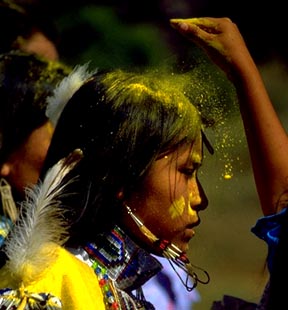
 First she will be blessed by the Diiyin, who will sprinkle an handful of pollen-based good-medicine over her head, as can be seen in this photo of Apache Diiyin Bert Hinton blessing a girl.
First she will be blessed by the Diiyin, who will sprinkle an handful of pollen-based good-medicine over her head, as can be seen in this photo of Apache Diiyin Bert Hinton blessing a girl.

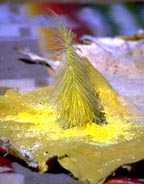 Some people find more to pray about than others, so sometimes it appears the line doesn't move at all, yet the girl must continue dancing, healing, keeping the power flowing.
Some people find more to pray about than others, so sometimes it appears the line doesn't move at all, yet the girl must continue dancing, healing, keeping the power flowing.
Much has been written about NA-IH-ES healing, but most of it differs from what I have actually observed, e.g., the girl DOES hold a sick baby (and lifts it up high above her head), and the girl WILL touch and massage a patient's body when directed to do so by the Diiyin. The fact that, after hours of activity under the desert sun, having the strength to lift anyone is quite an accomplishment!
Similar to most healing ceremonies, when the power is there, it is evident and everyone feels better for being there.
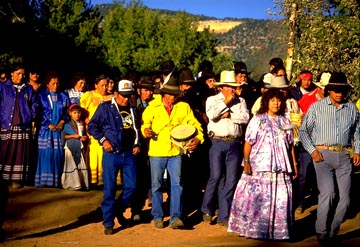
After blessings are finished, everyone but the clean-up crew return to their camps for more singing, dancing, and preparation for the night ceremony.
The clean-up crew remove all the rubbish,unload and pile up all the firewood, then lay out the site so people can navigate - and dance - safely in the black of night.